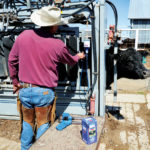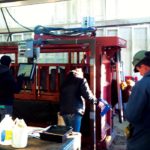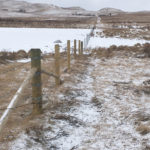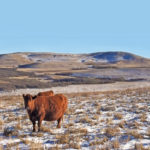
Wintering heifers at Fenton Hereford Ranch
Irma, Alta. operation develops approach that sees cattle thrive during the cold
Al Fenton of Fenton Herefords at Irma, Alta., has raised thousands of replacement heifers and has a pretty good idea about how to feed and grow them into cows. “We use fenceline weaning, which is low stress. We wean in a 10-acre area with cows on one side and calves on the other. It’s a […] Read more

Winter management for replacement heifers
Create a development plan that works for you
Good management of heifers, especially during winter, can make a big difference in their success as cows. Dr. Bart Lardner, research scientist with the Western Beef Development Centre (WBDC) and adjunct professor in the department of animal and poultry science at the University of Saskatchewan says the traditional recommendation, for the past 40 years, has […] Read more

Watch for urinary stones
Animal Health: Urinary blockages can be more common in early-castrated steers than bulls
Occasionally cattle suffer from kidney stones or bladder stones, just like humans. These are called urinary calculi, and are mineralized clumps in the urinary tract. In cattle, bladder stones are more common than kidney stones. Small ones usually pass out with urine and are not a problem, but sometimes stones become caught and create a […] Read more

A proper dosage of antibiotics is crucial for efficiency
Animal Health with Heather Smith Thomas
When treating cattle with antibiotics, dewormers and other medications, it is important to use the proper dosage — which is generally determined by the weight of the animal. Thus it is crucial to know, not guess the weight. Under-dosing may not give the desired results, and overdosing in some instances can be harmful. In the […] Read more

Do you have a veterinary-client-patient relationship?
Animal Health: VCPRs will soon be needed to prescribe antibiotics
The significance of veterinary-client-patient relationships (VCPR) is being elevated to a new level as Canadian veterinarians strive to fulfill their obligations for oversight of medically important antimicrobials in the global battle to check the spread of resistant bacteria. By the end of this year, veterinarians must have records on file to validate VCPRs before prescribing […] Read more

‘Software disease’ — The hazards of plastic, net wrap and twines
Animal Health: Ingestion of plastics has become a common killer
Cattle, especially young ones, are curious and chew on anything within reach. They may eat baling twines, plastic bags and other debris that ends up in their pen or pasture. The strange material may taste or smell interesting, so the animals chomp it down. Sometimes they accidentally ingest foreign objects in their feed. Cattle eat […] Read more
NDSU studies net wrap, twine ingestion in cattle
Beef specialist Carl Dahlen, North Dakota State University Animal Science Department, became interested in this problem after the NDSU diagnostic lab necropsied a case of acute bloat associated with ingestion from a large wad of net wrap. He decided to compare various materials to see how well they break down (or not) in the rumen […] Read more

Pro tips on building durable barbed-wire fences
Most fences for cattle utilize barbed wire, especially for large pastures, since a good barbed-wire fence is effective and much cheaper to build and maintain than rail fences or netting, and will last longer if properly installed. Jason Nelson has a ranch near Longview, in southern Alberta, and does custom fencing for many ranchers in […] Read more
Setting posts in difficult ground
Tips for rough ground
Building fence is more challenging in rocky, frozen or swampy ground when it’s impossible to dig post holes efficiently, or pound posts. Michael Thomas of Thomas and Son Custom Fencing, at Baker, Idaho, says options in rocks include chipping or prying the rocks out with a hand bar, or using a hammer drill. “This works […] Read more

All in on year-round grazing
Stephen Hughes’ family has operated the Chinook Ranch near Longview, Alta., since the late 1940s. It consists of 5,000 acres, roughly half in Crown lands, and most of it in tall grass prairie to carry 500 cows year-round plus 500 yearlings in the summer. It was a traditional operation, raising hay to carry the cows […] Read more


